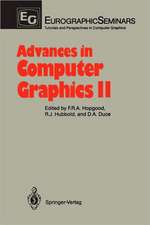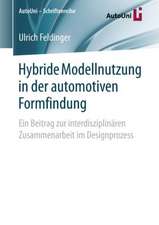Virtual Reality and Animation for MATLAB® and Simulink® Users: Visualization of Dynamic Models and Control Simulations
Autor Nassim Khaleden Limba Engleză Hardback – 3 ian 2012
· Gives the reader hands on example-base experience for simulating dynamical models in MATLAB®/Simulink® and animating them in VRML
· More than 150 images describe each step in the model realizations helping readers to understand them visually
· Diverse examples and profound problem treatment enable the reader to animate complex dynamical problems
m-files, Simulink models, VRML files and jpegs available for download provide full solutions for the end-of-chapter problems
Virtual Reality and Animation for MATLAB® and Simulink® Users demonstrates the simulation and animation of physical systems using the MATLAB® Virtual Reality Toolbox (virtual models are created in V-Realm Builder). The book is divided into two parts; the first addresses MATLAB® and the second Simulink®. The presentation is problem-based with each chapter teaching the reader a group of essential principles in the context of a step-by-step solution to a particular issue. Examples of the systems covered include mass-spring-dampers, a crank-slider mechanism and a moving vehicle. The examples are given in ascending level of difficulty and contain MATLAB®/Simulink® codes deliberately simplified so that readers can focus on:
• understanding how to link a 3-d virtual scene to MATLAB®/Simulink®; and
• manipulating the 3-d virtual scene in MATLAB®/Simulink®.
When studied in sequence, the chapters of this text form a coherent whole enabling the reader to gain a thorough expertise in virtual simulation and animation of dynamical models using MATLAB®/Simulink®. Individual chapters stand on their own, however, so that readers interested in a particular system can concentrate on it easily. Problemsare provided in each chapter to give practice in the techniques demonstrated and to extend the range of the systems studied, for example, into the control sphere. Solution code for these problems can be downloaded from insert URL.
Whether modeling the dynamics of a simple pendulum, a robot arm or a moving car, animation of a dynamical model can enliven and encourage understanding of mechanical systems and thus contribute to control design. Virtual Reality and Animation for MATLAB® and Simulink® Users will be instructive and interesting to anyone, researcher or student, working with the dynamics of physical systems. Readers are assumed to have some familiarity with MATLAB®.
| Toate formatele și edițiile | Preț | Express |
|---|---|---|
| Paperback (1) | 295.53 lei 38-44 zile | |
| SPRINGER LONDON – 30 apr 2017 | 295.53 lei 38-44 zile | |
| Hardback (1) | 331.25 lei 6-8 săpt. | |
| SPRINGER LONDON – 3 ian 2012 | 331.25 lei 6-8 săpt. |
Preț: 331.25 lei
Preț vechi: 414.07 lei
-20% Nou
Puncte Express: 497
Preț estimativ în valută:
63.40€ • 68.89$ • 53.29£
63.40€ • 68.89$ • 53.29£
Carte tipărită la comandă
Livrare economică 21 aprilie-05 mai
Preluare comenzi: 021 569.72.76
Specificații
ISBN-13: 9781447123293
ISBN-10: 1447123298
Pagini: 200
Ilustrații: VII, 174 p. 199 illus., 186 illus. in color. With online files/update.
Dimensiuni: 155 x 235 x 10 mm
Greutate: 0.39 kg
Ediția:2012
Editura: SPRINGER LONDON
Colecția Springer
Locul publicării:London, United Kingdom
ISBN-10: 1447123298
Pagini: 200
Ilustrații: VII, 174 p. 199 illus., 186 illus. in color. With online files/update.
Dimensiuni: 155 x 235 x 10 mm
Greutate: 0.39 kg
Ediția:2012
Editura: SPRINGER LONDON
Colecția Springer
Locul publicării:London, United Kingdom
Public țintă
ResearchCuprins
Introduction.- V-Realm Builder.- The Translating Cube.- Mass–Spring–Damper Oscillations.- The Crank–Slider Mechanism of a Piston.- Car Animation with Joystick Control.- Animation of a Ship Moving Across Waves.- Animation of a Translating Cube.- Animation of Mass–Spring–Damper Oscillations Using Simulink®.- Animation of the Crank–Slider Mechanism of a Piston Using Simulink®.- Car Animation with Joystick Control Using Simulink®.- Animation of a Ship Moving Across Waves Using Simulink®.
Notă biografică
Doctor Khaled’s Ph.D. thesis dealt with guidance and control of under-actuated ships. He modeled the dynamics of the ship under various environmental conditions in Simulink. Furthermore, he designed a patent-protected guidance system for autonomous operation of under-actuated ships. Then, he coupled the guidance system with a set of robust controllers to assess the overall performance of the system. To simplify debugging the full dynamic model of the ship and its interaction with wave, wind and current, he animated the system in Virtual Reality. Moreover, he captured these animations as video files which helped him in explaining the complex model of the ship, the randomness of the waves, the robustness of the coupled system of controllers and the guidance system to the audience of various conferences in which he presented his work. He also taught several linear control courses and used the Virtual Reality as a tool to illustrate the various applications of automatic control. Currently, He works in Cummins as a senior controls and diagnostics research engineer. He uses Virtual Reality to animate the dynamics of certain systems and actuators and these animations serve as demonstration videos for the systems.
Textul de pe ultima copertă
Virtual Reality and Animation for MATLAB® and Simulink® Users demonstrates the simulation and animation of physical systems using the MATLAB® Virtual Reality Toolbox (virtual models are created in V-Realm Builder). The book is divided into two parts; the first addresses MATLAB® and the second Simulink®. The presentation is problem-based with each chapter teaching the reader a group of essential principles in the context of a step-by-step solution to a particular issue. Examples of the systems covered include mass-spring-dampers, a crank-slider mechanism and a moving vehicle. The examples are given in ascending level of difficulty and contain MATLAB®/Simulink® codes deliberately simplified so that readers can focus on:
• understanding how to link a 3-d virtual scene to MATLAB®/Simulink®; and
• manipulating the 3-d virtual scene in MATLAB®/Simulink®.
When studied in sequence, the chapters of this text form a coherent whole enabling the reader to gain a thorough expertise in virtual simulation and animation of dynamical models using MATLAB®/Simulink®. Individual chapters stand on their own, however, so that readers interested in a particular system can concentrate on it easily. Problems are provided in each chapter to give practice in the techniques demonstrated and to extend the range of the systems studied, for example, into the control sphere. Solution code for these problems can be downloaded from insert URL.
Whether modeling the dynamics of a simple pendulum, a robot arm or a moving car, animation of a dynamical model can enliven and encourage understanding of mechanical systems and thus contribute to control design. Virtual Reality and Animation for MATLAB® and Simulink® Users will be instructive and interesting to anyone, researcher or student, working with the dynamics of physical systems. Readers are assumed to have some familiarity with MATLAB®.
• understanding how to link a 3-d virtual scene to MATLAB®/Simulink®; and
• manipulating the 3-d virtual scene in MATLAB®/Simulink®.
When studied in sequence, the chapters of this text form a coherent whole enabling the reader to gain a thorough expertise in virtual simulation and animation of dynamical models using MATLAB®/Simulink®. Individual chapters stand on their own, however, so that readers interested in a particular system can concentrate on it easily. Problems are provided in each chapter to give practice in the techniques demonstrated and to extend the range of the systems studied, for example, into the control sphere. Solution code for these problems can be downloaded from insert URL.
Whether modeling the dynamics of a simple pendulum, a robot arm or a moving car, animation of a dynamical model can enliven and encourage understanding of mechanical systems and thus contribute to control design. Virtual Reality and Animation for MATLAB® and Simulink® Users will be instructive and interesting to anyone, researcher or student, working with the dynamics of physical systems. Readers are assumed to have some familiarity with MATLAB®.
Caracteristici
Gives the reader hands on example-base experience for simulating dynamical models in MATLAB®/Simulink® and animating them in VRML More than 150 images describe each step in the model realizations helping readers to understand them visually Diverse examples and profound problem treatment enable the reader to animate complex dynamical problems m-files, Simulink models, VRML files and jpegs available for download provide full solutions for the end-of-chapter problems























